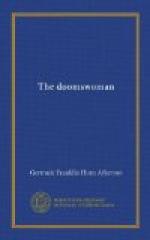We took a long siesta that day, but hours before dark the populace was crowded in the court-yard under the booth which had been erected during the afternoon. After the early supper the guests of Casa Grande, and our neighbors of the town, filled the sala, the large bare rooms adjoining, and the corridors. The old people of both degrees seated themselves in rows against the wall, the fiddles scraped, the guitars twanged, the flutes cooed, and the dancing began.
In the court-yard a small space was cleared, and changing couples danced El Jarabe and La Jota,—two stately jigs,—whilst the spectators applauded with wild and impartial enthusiasm, and Don Guillermo from the corridor threw silver coins at the dancers’ feet. Now and again a pretty girl would dance alone, her gay skirt lifted with the tips of her fingers, her eyes fixed upon the ground. A man would approach from behind and place his hat on her head. Perhaps she would toss it saucily aside, perhaps let it rest on her coquettish braids,—a token that its owner was her accepted gallant for the evening.
Above, the slender men and women of the aristocracy, the former in black and white, the latter in gowns of vivid richness, danced the contradanza, the most graceful dance I have ever seen; and since those Californian days I have lived in almost every capital of Europe. The music is so monotonous and sweet, the figures so melting and harmonious, that to both spectator and dancer comes a dreaming languid contentment, as were the senses swimming on the brink of sleep. Chonita and Valencia were famous rivals in its rendering, always the sala-stars to those not dancing. Valencia was the perfection of grace, but it was the grace now of the snake, again of the cat. She suggested fangs and claws, a repressed propensity to sudden leaps. Chonita’s grace was that of rhythmical music imprisoned in a woman’s form of proportions so perfect that she seemed to dissolve from one figure into another, swaying, bending, gliding. The soul of grace emanated from her, too evanescent to be seen, but felt as one feels perfume or the something that is not color in the heart of a rose. Her star-like eyes were open, but the brain behind them was half asleep: she danced by instinct.
I was watching the dancing of these two,—the poetry of promise and the poetry of death,—when suddenly Don Guillermo entered the room, stamped his foot, pulled out his rosary, and instantly we all went down on our knees. It was eight of the clock, and this ceremony was never omitted in Casa Grande, be the occasion festive or domestic. When we had told our beads, Don Guillermo rose, put his rosary in his pocket, trotted out, and the dancing was resumed.
As the contradanza and its ensuing waltz finished, Estenega went up to Chonita. “You are too tired to dance any more to-night,” he said. “Let us sit here and talk. Besides, I do not like to see you whirling about the room in men’s arms.”




